Homegrown kiwi fruit can be a rewarding and successful experience. Kiwis are tasty, healthy, and high in vitamins, minerals, and antioxidants. They’re also pretty straightforward to grow if you have the right conditions and follow a few basic procedures. But first, there are a few things you should know about these fuzzy fruits.
There’s a lot to learn about growing kiwi fruit at home, from selecting the correct kind to preparing the soil, and from planting and trimming to harvesting and preserving. We’ll walk you through the procedure step by step in this post so you may savor the sweet taste of accomplishment and wow your friends and family with your green thumb.
A Brief History
The kiwi fruit (kiwi is also a bird in New Zealand), also known as the Chinese gooseberry, has a long and interesting history. Originally native to China, kiwis were first cultivated and enjoyed by the Chinese for their sweet and tangy flavor and medicinal properties.
In the early 20th century, kiwi seeds were brought to New Zealand by a schoolteacher named Isabel Fraser, who had obtained them from a missionary in China. The seeds were planted in New Zealand soil, and over time, a new type of kiwi fruit was developed that was larger, sweeter, and more flavorful than its Chinese counterpart. The fruit was eventually named after the national bird of New Zealand, the kiwi bird, due to its similar shape and texture.
From there, the popularity of kiwi fruit grew, and it spread to other countries around the world, including Italy, where it is now one of the main producers of kiwi fruit. Today, kiwi fruit is enjoyed by millions of people worldwide, and it continues to be a popular choice for its unique flavor and nutritional benefits.
Kiwifruit is now grown on every continent except Antarctica. It is a popular fruit, known for its delicious taste, its ease of growth, and its numerous health benefits. Kiwi plants are hardy deciduous climbers that produce dozens of small fruits after two to five years of planting.
Kiwifruit can be planted from seeds, seedlings, or cuttings. When planting more than one vine, they should be spaced at least 3-4.5m (10-15ft) apart and with a spacing of 5-6 metres between plants. Vines need plenty of sun throughout the day and should be watered and fertilized regularly.
Kiwifruit is an easy plant to grow at home and care for with minimal effort. With proper care and maintenance, you can enjoy delicious kiwis right from your own garden!
Nutritional Benefits
Kiwifruit is a nutrient-rich fruit that offers numerous health benefits. It is high in fiber, carotenoids, vitamin C, and other essential nutrients. Eating kiwifruit regularly can help lower blood pressure, improve digestion, boost immunity, and provide a range of other health benefits.
Kiwifruit is an excellent source of dietary fiber. The high fiber content helps to reduce cholesterol levels, which in turn can help reduce the risk of heart disease. Fiber also contributes to improved digestion and regular bowel movements.
Kiwifruit is a good source of antioxidants. Antioxidants help protect your body from damage caused by free radicals and can reduce inflammation. They also play a role in helping to prevent chronic diseases like heart disease and cancer.
Kiwifruit is a good source of vitamin C, which helps to boost the immune system and helps protect cells from damage caused by free radicals. Vitamin C also helps to form collagen and helps the body absorb iron from food sources.
Kiwifruit contains carotenoids, which are plant pigments that give fruits and vegetables their bright colors. Carotenoids are powerful antioxidants that protect cells from damage caused by free radicals and help reduce inflammation in the body.
Kiwifruit also contains vitamins A and E as well as folate, potassium, magnesium, copper, zinc, phosphorus, lutein, and zeaxanthin. These nutrients are essential for maintaining good health. Eating kiwifruit regularly can help keep your body functioning optimally.
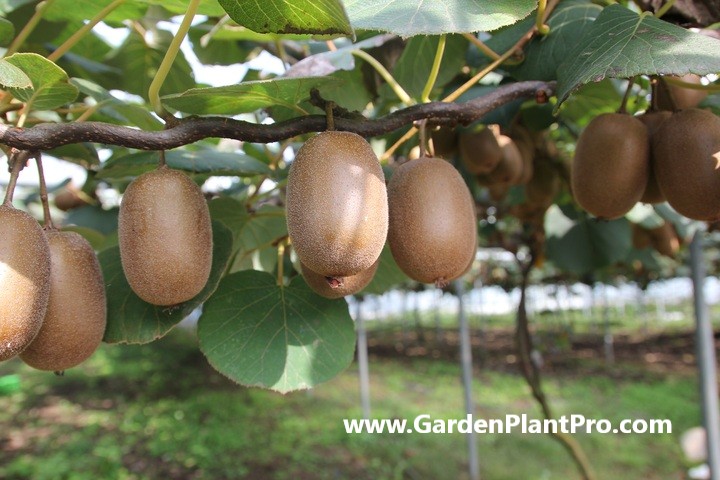
Common Varieties & Their Uses
Kiwi fruit come in two main varieties – the kiwifruit (Actinidia deliciosa) and the hardy kiwi or kiwiberry (Actinidia arguta, A. kolomikta). Both varieties grow in home gardens, but each has its own distinct characteristics and uses.
Kiwifruit are the most commonly grown variety, and are primarily eaten fresh as a snack or dessert. The fuzzy outer skin is usually removed before eating, and the sweet flesh can be scooped out with a spoon. Kiwifruit contain more vitamin C than an orange and are also a good source of dietary fiber, potassium, magnesium, and folate.
Hardy kiwi or kiwiberry plants have attractive foliage and can be grown for ornamental purposes even if they aren’t producing fruit. They’re also edible, but tend to be smaller with more tart flavor than kiwifruit. The sweet-tart flavor makes them ideal for adding to salads or cooked dishes. Hardy kiwi vines can be trained to climb fences or trellises for a stunning display.
When planting more than one vine, it’s important to space them at least 3m (10ft) apart so they don’t get tangled up in each other but are still close enough to improve pollination. All male varieties will pollinate all female varieties; however, variety development of hardy kiwi is still in its infancy due to its relative newness on the market.
No matter which variety you choose, both require plenty of sun and well-drained soil that is slightly acidic (pH 6–7). Mixing organic compost into the soil will improve growth, and then the vines should be given twice-yearly applications of fertilizer for best results. Water regularly throughout the growing season.
When To Sow
If you’re interested in growing kiwi fruit at home, the first step is to decide when to sow the seeds. Kiwi seeds should be sown in the late winter or early spring, when the soil is moist and the temperatures are mild. This is because kiwi plants require a long growing season to produce fruit, and they need to establish their root systems before the hot summer months arrive.
DIY PROJECT: Collect rainwater no matter where you live...
This DIY project is the best way to legally collect rainwater NO MATTER where you live. Get chlorine-free water, cut down on your water bills, and have enough for an emergency situation or to water your garden. Read More Here...
However, you should avoid sowing kiwi seeds too early, as the seedlings may be vulnerable to frost damage. On the other hand, if you sow the seeds too late, the plants may not have enough time to mature and produce fruit before the winter months arrive.
When planting kiwifruit, choose a location that receives full sun or partial shade throughout the year. The more sun the plant gets, the better. Ensure that the soil is nutrient-rich and moisture-retentive, and if planting against a wall then set the plant at least a foot away. Plant your kiwifruit vine somewhere that is protected from late spring frosts that might damage newly emerged growth. Water regularly to keep the soil moist but not waterlogged as this could lead to root rot.
It is also important to fertilize your kiwifruit plant regularly throughout the season with an organic fertilizer. This will help ensure that it gets all of the nutrients it needs to thrive. Finally, make sure to choose a well-ripened and preferably organic kiwi fruit for optimal results when sowing your vines.
Choose Location & Prepare The Soil
Choosing the right location and preparing the soil are essential steps in growing kiwi fruit at home. Kiwi vines need a sunny spot to produce the best growth and fruit, so be sure to choose a spot with plenty of direct sunlight and protection from strong winds.
Plant your kiwi fruit into nutrient-rich, moisture-retentive soil with a pH between 5.0 and 6.5. If you are planting against a wall then set the plant at least a foot away from the wall to prevent sunburn and wind damage. Enrich the soil with plenty of compost or well-rotted manure and add some slow-release fertilizer for extra nutrition.
Before planting, soak plants in water for about an hour to ensure that they are fully hydrated. Dig a generous hole for your vine and space plants at least five strides apart. Once planted, water your kiwi fruit regularly and mulch around the base of plants to retain moisture and suppress weeds.
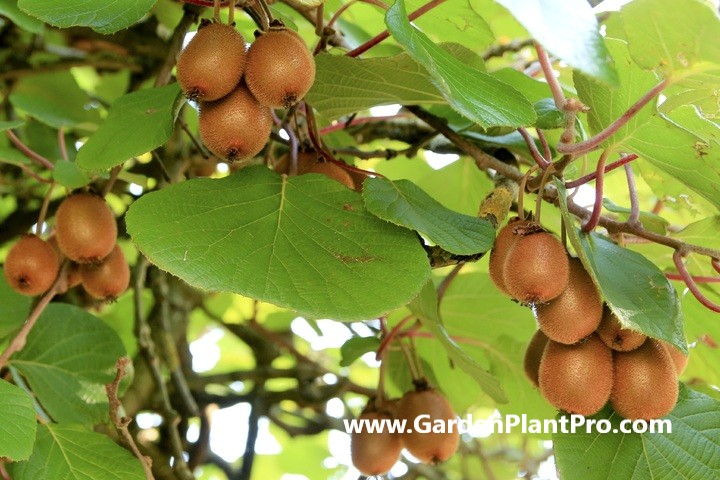
Plant The Seeds, Seedlings Or Cuttings
When growing kiwi fruit, you can either sow the seeds, start with seedlings, or take cuttings. All three methods can produce successful plants with delicious and nutritious fruit.
To sow the seeds, remove them from a mature kiwi and let them dry for two days. Place the seeds in a container with moist perlite and refrigerate at 40°F (4°C). Once ready, sow the seeds in sand, well-drained potting mix, or on damp kitchen paper. Keep them moist and they should germinate within two weeks.
If you’re starting with seedlings, choose varieties that will produce fruit in your climate and soil type. Plant your seedlings into holes that are twice as wide as the root ball and deep enough to cover the entire root ball. Backfill with soil mix, gently firming down around the root ball. Position the plant in full sun and water thoroughly after planting.
Kiwi plants are usually propagated asexually by grafting fruiting varieties onto rootstock or by rooting kiwi cuttings. To take cuttings, choose new growth that is approximately 4 inches in length and make a clean cut just below a leaf node. Dip the cutting into rooting hormone powder and place it into a pot of well-draining soil mix. Keep it moist during the rooting period and then gradually increase watering when roots begin to form.
Once planted, water your kiwi plants regularly to keep the soil moist but not soggy, especially during dry spells or periods of extended heat. Fertilize your plants every couple of months with a balanced fertilizer to encourage healthy growth and strong yields of fruit.
If needed, provide support for sprawling vines to prevent breakage from strong winds or heavy fruit loads. With proper care and maintenance, you’ll be able to enjoy delicious homegrown kiwi fruits for years to come.
Watering & Fertilizing
Watering and fertilizing are key components of successful kiwi fruit cultivation. The plants need to be kept moist, but not soggy, and they need to be fertilized in order to produce a healthy crop.
In the first year of planting, it is best not to fertilize the kiwi plants. This will give them an opportunity to establish their root systems before being subject to the stress of additional nutrients.
Once the plants have established themselves, water them one or two days before applying any fertilizer or manure. It is important that the soil around the base of the plant is kept moist for several weeks while it establishes itself. Mulching with compost or straw can help retain moisture and provide additional nutrients.
When it comes time to fertilize your kiwi plants, apply the recommended amount of granular fertilizer according to the manufacturer’s instructions. Do this in late winter or early spring for best results. Periodic applications of dolomitic limestone may also be required to maintain a proper pH balance (5.0-6.5) and provide magnesium for your plants.
Keep in mind that only self-fertile varieties will produce fruit without having a male and female plant nearby, so make sure you choose the right variety when planting your kiwis. If you want a larger crop, you’ll need both male and female plants nearby in order for them to pollinate each other.
Do you have some charcoal in your house right now? We call charcoal a “miracle leftover” for anyone who wants to be a little more self-sufficient and cut costs. That’s because it can help you with so many different things around the house and garden. You can even use it to make an energy-free fridge. Read More Here...
Maintenance
Maintaining a kiwi fruit vine is an important part of successful fruit production.
Vigorous pruning is needed annually to remove dead wood, thin the canopy and promote new growth. Pruning should be done in early spring before bud break to help reduce disease pressure. Pruning should also be done in late summer or early fall to reduce the size of the vine and control its shape. The goal is to keep the vine from becoming overly vigorous and producing too much fruit.
It is also important to maintain soil fertility and pH levels. Soil fertility can be maintained by adding organic matter such as compost or manure each year. A soil test should be conducted annually to check for nutrient deficiencies or pH levels that need adjustment.
It is important to water kiwi fruit vines regularly during the growing season, especially during times of drought or heat stress. The vines should be watered deeply but not too often; once a week or every two weeks is usually enough. Proper watering encourages deep root growth and helps prevent disease and pests.
Weeds should be regularly removed around the base of the vine to prevent competition for nutrients and water. It is also important to monitor for pests and diseases, as well as signs of nutrient deficiencies or other problems that may need attention. Regular inspections can help you identify problems early on before they become serious issues.
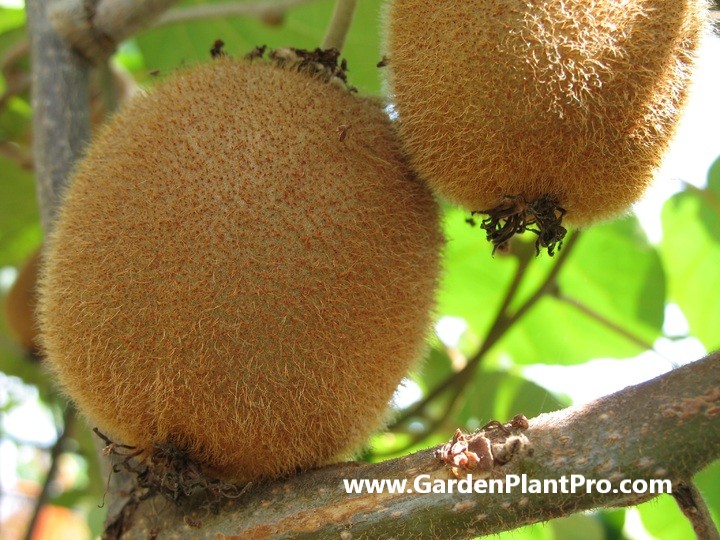
When & How To Harvest
After months of tending to your kiwi plants, the moment of truth has finally arrived: it’s time to harvest your fruit! But when is the best time to do so, and how do you know when your kiwis are ready? The answer depends on several factors, including the variety of kiwi fruit you are growing, the climate and growing conditions in your area, and your personal preferences for ripeness and flavor.
Generally, kiwi fruit is ready to harvest in the late summer, early autumn. You can tell that the fruit is ready by gently pressing on it with your fingers; if it gives slightly and feels soft to the touch, it’s likely ready to be picked. However, you should also check the color of the fruit; ripe kiwis should be a dark green or brownish color, depending on the variety. Size and date can also be used as indicators of readiness for harvest. A single kiwifruit vine can produce 22 to 33 pounds of fruit each year, so make sure you have enough room for them (or share them around).
To harvest your kiwi fruit, simply cut the stem with a sharp knife or scissors, being careful not to damage the fruit or the plant. You can also gently twist the fruit off the stem, but be careful not to pull too hard or you may damage the plant or the fruit. Make sure all the fruits are picked before the first frost, as they will not ripen further thereafter.
After harvesting your kiwi fruit, it’s important to store it properly to ensure maximum freshness and flavor. Kiwis can be stored in a cool, dry place for up to several weeks, or in the refrigerator for even longer. You can also freeze kiwi fruit for later use in smoothies or other recipes.
Storing & Preserving
Once you have harvested your kiwi fruits, it is important to store them properly to ensure they remain fresh and delicious. To store kiwi fruits, select only those that are firm and free of bruises.
Place them in a paper bag with a few holes in it and store in the refrigerator. Fruits can be kept in the fridge for up to two weeks, but will begin to lose flavor after that time.
For long-term storage, you can freeze your kiwis. To do this, peel and slice the fruit before freezing on a parchment-lined baking sheet. Once frozen, transfer the slices to an airtight container or bag for up to six months. When ready to use, just thaw the slices at room temperature or in the refrigerator overnight before eating.
In addition to freezing or refrigerating kiwifruit, you can also preserve them in other ways. Drying is one option; simply slice the fruit into thin pieces and dry in a food dehydrator for about six hours until crisp. You can also make jams, jellies and sauces using kiwi fruits as well as pickling them for later use.
No matter how you choose to store or preserve your kiwifruit, it is important to remember that they are highly perishable and should always be handled with care. Make sure to keep them at the right temperature, away from direct sunlight and moisture, and be sure to consume them within a few days of harvesting for maximum freshness and flavor.
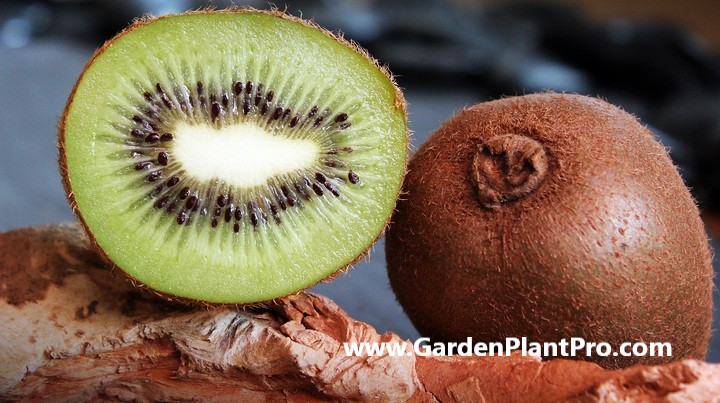
Common Diseases & How To Control Them
When it comes to treating kiwi diseases, an ounce of prevention is definitely worth a pound of cure. Healthy kiwi plants are disease resistant, so it’s important to provide the best growing conditions possible. This includes ensuring that the soil is well-drained and amended with compost, planting in a sunny spot, and keeping the area free of weeds, debris and other plants that could act as hosts for disease-causing organisms.
To keep diseases at bay, it’s important to practice good garden hygiene. This includes removing infected leaves and branches as soon as possible, and disinfecting pruning tools between uses. If you suspect your plant has been infected with a disease, it’s best to contact your local cooperative extension office for advice on how to treat it.
The most common diseases affecting kiwifruit are root rots, blight, powdery mildew and anthracnose. Root rots can be caused by several different fungi and are often associated with poorly drained soils or over-watering. Symptoms include stunted growth and yellowing leaves. To prevent root rots, make sure your soil has good drainage and only water when necessary.
CASE STUDY: We've been living off the grid for the last 40 years...
In all that time an electric wire has never been connected to our house. We haven’t gotten or paid an electricity bill in over 40 years, but we have all the electricity we want. We grow everything we need, here, in our small backyard. We also have a small medicinal garden for tough times. Read More Here...
Blight is caused by fungi that can affect both young and mature plants and can cause leaves to turn yellow and drop off. To control blight, remove affected leaves and branches as soon as possible and dispose of them away from the garden. Avoid overhead watering as this can spread the disease spores.
Powdery mildew is another common fungal disease that can affect young plants in humid or wet conditions. It is easily identifiable by the white powdery growth on the leaves and stems of the plant. To control powdery mildew, prune off infected parts of the plant, increase air circulation around the plant by removing nearby plants or debris, and water early in the day so that the foliage has time to dry out before nightfall.
Anthracnose is another fungal disease that can affect kiwi plants, and it’s a bit more serious than powdery mildew. It’s caused by a fungus that attacks the roots of the plant, which can lead to stunted growth and reduced fruit production. Symptoms of anthracnose include brown or black spots on the leaves and fruit, as well as cracking and splitting of the fruit.
To control anthracnose, it’s important to keep the area around the plant free of debris and weeds, and to avoid overwatering the plant. Fungicides can also be used to prevent the spread of the disease, but it’s important to use them according to the instructions on the label and to wear protective clothing when applying them.
Common Pests & How To Control Them
Common pests are a common problem for kiwifruit growers.
Two-spotted spider mites, leaf rollers, thrips, and Japanese beetles can all affect these plants. To control these pests, you should treat the soil before planting with an appropriate insecticide. Healthy plants are more resistant to pests than those that are already weakened or stressed.
Cultural practices such as proper pruning and spacing of vines can also help deter pests. Vines should be spaced at least 3m (10ft) apart so they don’t get tangled up in each other but are still close enough to promote good pollination. Pruning should be done carefully to ensure that the plant is kept healthy and vigorous.
For ongoing pest control, a 4-inch layer of wood chip mulch can help control weeds and trunk guards can protect vines from rodent damage and sunscald. Insect damage is rare on kiwifruit plants, however it is important to keep an eye out for signs of infestation or damage. If any pests are spotted, they should be identified and appropriate control measures taken quickly. Council may also enforce the control of certain pest species in some cases.
Other Tips & Tricks
Once you’ve planted your kiwi fruit, there are a few other tips and tricks to keep in mind in order to ensure a successful harvest. Pruning is an important part of growing kiwi fruit and should be done during the winter months or early spring. This will help promote strong growth, so make sure to regularly trim back the shoots and remove any dead or damaged branches. Additionally, make sure to keep the area around the plants free from weeds as these can compete with the kiwi plants for nutrients.
It’s also important to be aware of common pests and diseases that can affect your kiwi crop. Look out for aphids, thrips, caterpillars, mealybugs, mites, and powdery mildew. If any of these appear on your plants, act quickly and use an appropriate insecticide or fungicide to treat them. Additionally, it may be beneficial to use companion planting to help repel pests naturally. For example, herbs like sage and rosemary have been found to be effective in repelling certain types of bugs.
Finally, don’t forget about harvesting! The best time to pick your kiwis is when they’re fully ripe and have a deep green color with a slight fuzzy texture. Gently twist them off the vine and enjoy!
Companion Planting
Companion planting is an important part of growing kiwi fruit at home. Not every plant is an ideal companion for kiwi, but those that are can help the plants grow more vigorously and fruit more prolifically. Some of the plants that can be planted around kiwi include grape, geranium, currants, lavender, and marjoram. Strawberries can also be planted together with kiwifruit.
Kiwifruit is not known to compete with other plants for nutrients, so they can do well in a raised bed filled with sterilized soil and organic compost. It is important to set the plant at least a foot away from the base of walls or trellises so that the roots don’t sit in a rain puddle. Kiwis do best in well-draining loamy to lightly heavy soil that is rich with organic matter like leaf mold, compost or aged manure.
When planting kiwi plants, it is best to separate them by approximately 8-10 feet to ensure enough air circulation and sun exposure for each plant. It also helps to provide full sun for your kiwi vine to thrive in your garden.
In order to get fruit from your kiwi vines, you will need to plant one male and one female plant since males supply the pollen and females produce the berries. With proper care and companion planting, you should be able to enjoy plenty of delicious kiwifruit from your own garden!
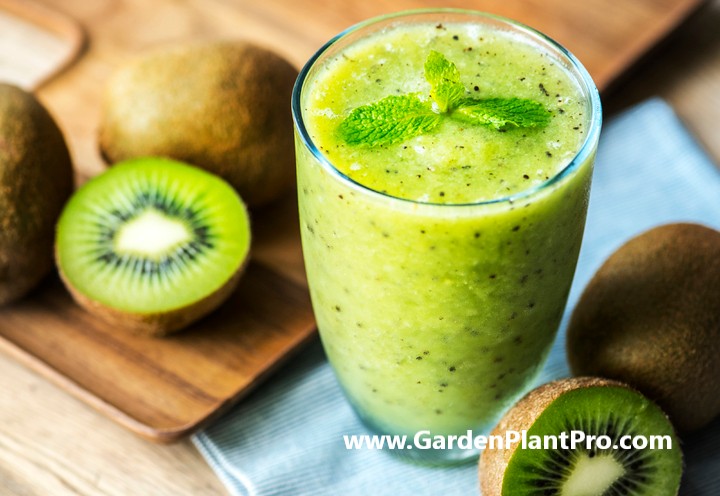
Using Your Harvest
Once your kiwi fruit is ready to harvest, it is important to handle it with care in order to extend its storage life. To harvest kiwi, snap the stem at the vine and gently twist the fruit off.
It is best to place the kiwi into a container with a soft bottom such as a cloth bag or basket in order to avoid bruising. When storing kiwi, keep them in a cool place such as a refrigerator or cellar. They may also be frozen for up to three months.
When it comes to using your harvest, there are many options available. Kiwi can be eaten fresh, added to smoothies, used to make jams and jellies, or dried and used as a crunchy snack. The possibilities are endless!
Kiwi is also an excellent source of Vitamin C and antioxidants, making it a great addition to any diet. Additionally, its high fiber content makes it a great source of dietary fiber. It can even be used as a natural laxative when consumed in large amounts!
Finally, kiwi can also be used for decorative purposes. Its bright green color makes it an ideal addition for fruit salads or other creative dishes and can add some visual appeal to any plate.
At the end of the day, no matter how you choose to use your kiwi harvest, you are sure to enjoy its sweet flavor and nutritional benefits!




